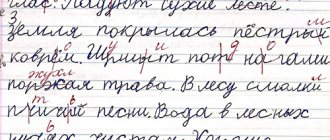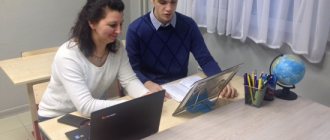Author of the material: Ermolaeva Zhannetta Evgenievna -
Co-founder of the portal Eduneo.ru, candidate of philological sciences, associate professor, speech therapist, linguist expert.
Expert: in the field of Russian language, literature, teaching methods, speech therapy
Author's project: online platform for expert teachers Eduneo
A child’s full speech is one of the means of increasing his level of communication skills, a way of developing him as an individual, and ultimately a way of achieving the best social adaptation.
Among speech disorders, deficiencies in written speech occupy a special place.
Dysgraphia is a partial disorder of the writing process associated with insufficient formation (or decay) of mental functions involved in the implementation and control of written speech.
Depending on the immaturity or impairment of a particular writing operation, 5 forms of dysgraphia are distinguished:
- articulatory-acoustic;
- acoustic;
- dysgraphia due to immaturity of language analysis and synthesis;
- ungrammatical;
- optical dysgraphia.
Along with “pure” forms of dysgraphia, mixed forms are encountered in speech therapy practice.
Let's consider those game exercises that will be useful for an elementary school teacher to correct Optical Dysgraphia.
The following errors are typical for the manifestation of optical dysgraphia:
- replacing letters consisting of different numbers of identical elements;
- replacement of similar, but differently located letter elements in space;
- omissions, not completing elements of letters;
- mirror image of letters.
Article:
The article discusses the issue of the content of the term “Dysgraphia”, “Optical dysgraphia”.
Examples of optical dysgraphia and kinetic errors in optical dysgraphia are given. The classifications of dysgraphia by different authors are compared. In recent years, many researchers have noted a significant increase in the number of children with developmental problems. This also applies to children with mental retardation. When children enter school, they experience difficulties in the learning process, in particular, difficulties in writing. In modern literature, persistent writing disorders are referred to as dysgraphia.
Symptoms of dysgraphia are considered to be persistent errors in the written work of school-age children, which are not associated with ignorance or inability to apply spelling rules.
Many authors believe that the cause of optical dysgraphia is a violation or underdevelopment of optical speech systems in the brain, as a result of which the child experiences instability of visual impressions and ideas. Individual letters are not recognized and do not correspond to certain sounds. At different moments, letters are perceived differently. Optical dysgraphia is associated with underdevelopment of visual gnosis, visual analysis and synthesis, spatial representations and manifests itself in substitutions and distortions of letters in writing.
The content of the term “dysgraphia” is defined differently in modern literature. R.I. Lalaeva gives the following definition: dysgraphia is a partial violation of the writing process, manifested in persistent, repeated errors caused by the immaturity of the higher mental functions involved in the writing process.
I.N. Sadovnikova defines dysgraphia (in younger schoolchildren) as a difficulty in mastering written language, the main symptom of which is the presence of persistent specific errors. In secondary school students, the occurrence of such errors is not associated with a decrease in intellectual development, hearing and vision impairment, or irregular schooling.
A. N. Kornev calls the persistent inability to master writing skills according to the rules of graphics dysgraphia (i.e., guided by the phonetic principle of writing) despite a sufficient level of intellectual and speech development and the absence of severe visual and hearing impairments.
Classifications of dysgraphia
There are several classifications of dysgraphia proposed by different authors; let’s analyze some of them.
O. A. Tokareva identifies 3 types of dysgraphia:
1. Acoustic; 2. Optical; 3. Motor;
Let's look at each type:
1. Acoustic dysgraphia is characterized by insufficient development of sound analysis and synthesis (mixtures and omissions, substitutions of letters are common).
2. Optical dysgraphia is caused by instability of visual impressions and ideas. Individual letters are not recognized and do not correspond to certain sounds. At different moments, letters are perceived differently. Due to inaccuracy of visual perception, they are mixed in writing.
3. With motor dysgraphia, there are difficulties in moving the hand while writing, a disruption in the connection of motor images of sounds and words with visual images.
The following types of dysgraphia were identified by M. E. Khvattsev:
1. Dysgraphia due to acoustic agnosia and phonemic hearing defects; 2. Dysgraphia due to oral speech disorders; 3. Dysgraphia due to impaired pronunciation rhythm; 4. Optical dysgraphia; 5. Dysgraphia with motor and sensory aphasia;
Let's describe them in more detail:
1. Dysgraphia due to acoustic agnosia and phonemic hearing defects. The physiological mechanism of the defect is a violation of associative connections between vision and hearing. In this type, cheating is intact, but omissions, rearrangements, substitutions of letters, merging of two words into one, omissions of words, etc. are observed.
2. Dysgraphia due to oral speech disorders. Arises due to incorrect sound pronunciation. The replacement of some sounds with others, the absence of sounds in pronunciation cause corresponding replacements and omissions of sounds in writing.
3. Dysgraphia due to a violation of the pronunciation rhythm. As a result of a disorder of the pronunciation rhythm, omissions of vowels, syllables, and endings appear in writing.
4. Optical dysgraphia is caused by a disorder or underdevelopment of the optical speech systems in the brain. (The formation of a visual image of a letter, word, distortion, replacement is disrupted; there is no distinction between graphically similar handwritten letters).
5. Dysgraphia in motor and sensory aphasia manifests itself in substitutions and distortions of the structure of words and sentences and is caused by the disintegration of oral speech due to organic damage to the brain.
Currently, the most correct classification, which is based on the immaturity of certain operations of the writing process, was developed by employees of the Department of Speech Therapy of Leningrad State Pedagogical Institute named after. A.I. Herzen.
The following types of dysgraphia are distinguished:
1. Articulatory-acoustic dysgraphia. 2. Dysgraphia based on disorders of phoneme recognition (phoneme differentiation). 3. Dysgraphia due to a violation of language analysis and synthesis. 4. Agrammatic dysgraphia. 5. Optical dysgraphia.
Let's look at each type in more detail:
1. Articulatory-acoustic dysgraphia is in many ways similar to that identified by M.E. Khvattsev dysgraphia due to oral speech disorders. The child writes as he pronounces.
According to L.S. Volkova, this type of dysgraphia manifests itself in substitutions and omissions of letters corresponding to substitutions and omissions of sounds in oral speech.
2. Dysgraphia based on disorders of phoneme recognition (acoustic dysgraphia) . Manifests itself in substitutions of letters corresponding to phonetically similar sounds. At the same time, in oral speech, sounds are pronounced correctly. Most often, letters denoting the following sounds are replaced: whistling and hissing, voiced and voiceless, affricates and the components that make up them (ch - t, ch - sch, ts - t, ts - s).
3. Dysgraphia due to a violation of language analysis and synthesis. The mechanism of this type of dysgraphia is a violation of the following forms of language analysis and synthesis: analysis of sentences into words, syllabic and phonemic analysis and synthesis.
The most common errors in this type of dysgraphia are distortions of the sound-letter structure of a word, caused by underdevelopment of phonemic analysis, which is the most complex form of language analysis.
4. Agrammatic dysgraphia . This type of dysgraphia manifests itself in agrammatisms in writing and is caused by the immaturity of the lexico-grammatical structure of speech.
5.Optical dysgraphia. This type of dysgraphia is caused by the immaturity of visual-spatial functions and is associated with a mixture of letters that are similar in spelling.
With optical dysgraphia, the following types of writing disorders are observed:
• distorted reproduction of letters in writing (incorrect reproduction of the spatial relationship of letter elements, mirror writing of letters, underwriting of elements, extra elements); • replacement and mixing of graphically similar letters. In total, either letters that differ in one element are mixed (p - t, w - i, l - m), or letters consisting of the same or similar elements, but differently located in space ( p - n, m - w).
One of the striking manifestations of optical dysgraphia is mirror writing: mirror writing of letters, writing from left to right, which can be observed in left-handed people with organic brain damage.
Scientists distinguish different types of dysgraphia, but in all classifications (O.A. Tokareva, M.E. Khvattseva, etc.) such a type as optical dysgraphia is presented.
Optical dysgraphia is dysgraphia, which is associated with underdevelopment of visual gnosis, analysis, synthesis, spatial representations and manifests itself in substitutions and distortions of letters in writing. Optical dysgraphia also includes mirror writing.
Optical dysgraphia has now become increasingly common in school-age children. It is not associated with speech underdevelopment of the child, it has no connection with oral speech, therefore this type of dysgraphia can appear even in a schoolchild with a high level of intellectual development.
Optical dysgraphia occurs due to the immaturity of visual-spatial functions: visual gnosis, visual analysis and synthesis, spatial representations. As a result, the child does not recognize a letter, cannot correlate it with the necessary sound, at different periods of time the same letter can be perceived differently differently. During writing, there is a mixture of handwritten letters, for example, p-n, u-i, m-l, b-d, etc.
From the perspective of neuropsychology, optical dysgraphia is considered by T.V. Akhutina. The ability to combine into a single whole, remember the relative positions of elements, and be able to coordinate words depends on the work of the right hemisphere.
During her study, Akhutina identified the following features of this writing disorder:
• mirror writing of letters; • difficulties in orienting to notebooks; • mismatch of letter elements in size; • fluctuations in the height and inclination of letters; • replacement of optically similar letters with each other; • violation of the order of letters in a word.
I.N. Sadovnikova established a new type of specific errors - mixing letters by kinetic similarity. She argues that researchers traditionally explain the mixing of letters by the optical similarity of the letters in the written form. The inclusion of another analyzer - an engine - in the act of writing is considered only as a necessary means to ensure the technical side of writing. But we need to take into account the qualitative restructuring that occurs in the associative chain of auditory-speech motor and visual-motor representations that support the writing process.
Let's look at examples of mixing letters in writing based on kinetic similarity:
- o-a (in the shock position) – bow-bont, lessons – uraki;
- b-d - bear - mebved, apples - yadlok; i-u - nature - pruroda, round - crooked;
- t-p - saved - stasli, station - spania;
- h-zh - shaggy-shaggy, polite - agile;
- l-i - February - February, key - kyayuch;
- gr - river - gechka, head - rolova.
In addition, the following letters are mixed: l-m, ch-b, n-yu, i-sh, a-d, u-ch, p-t, l-m, n-k.
In the above substitutions, attention is drawn to the coincidence of the outline of the first element of the interchangeable letters . Having written the first element, the child was unable to further differentiate the subtle movements of the hand in accordance with the plan: he either incorrectly conveyed the number of homogeneous elements (l-m, p-t, i-sh...), or incorrectly chose the subsequent element (u-i, g -r, b-d...).
Children with dysgraphia need special correctional assistance, since they cannot be overcome with conventional pedagogical methods. There must be competent step-by-step work with a speech therapist teacher.
Timely identification, prevention and correction of optical dysgraphia in younger schoolchildren will prevent errors from transferring to the middle level of school.
Bibliography:
1. Kornev, A.N. Reading and writing disorders in children: Educational and didactic manual. St. Petersburg: Publishing House "MiM", 1997 - 286 p. 2. Lalaeva, R.I., Benediktova, L.V. Reading and writing disorders in primary schoolchildren. Diagnostics and correction - Rostov n/d: “Phoenix”, St. Petersburg: “Soyuz”, 2014. – 224 p. (Series “Correctional pedagogy”). 3. Speech therapy: textbook for students. defectol. fak. higher educational institutions / ed. L.S. Volkova. – 5th ed., revised. and additional - M.: Humanitarian. ed. VLADOS Center, 2008. – 703 p. 4. Sadovnikova, I.N. Impairments of written speech and their overcoming in primary schoolchildren: Textbook - M.: Vlados, 1995. - 256 p. 5. Tokareva, O.A. Reading and writing disorders (dyslexia and dysgraphia) // Speech disorders in children and adolescents. / Ed. S.S. Lyapidevsky. - M., 1969. - P.39-45.








